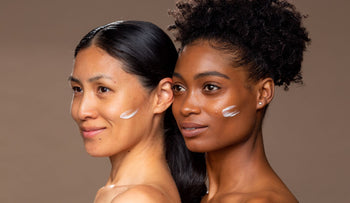Since their first use in skincare in the mid-20th century, retinoids like Retinol have been the gold standard in anti-aging. Many of the best anti-aging creams and wrinkle serums are powered by Retinol. Simply put, when it is stabilized, Retinol is one of the most effective solutions for addressing a broad range of skin-aging concerns.
Did you know that RoC was the first to discover the method for stabilizing Retinol more than 25 years ago? Our proprietary formula, process and packaging all combine to protect retinol and enhance its safety and effectiveness for daily use.
To this day, every RoC formula is scientifically crafted and clinically tested to ensure the best quality and efficacy – from the moment you open your favorite RoC product to the very last drop.
What is Retinol and What Does Retinol Do for Your Skin?
Retinol, a Vitamin A derivative, possesses multiple anti-aging and positive health benefits for your skin. Among these are the smoothing of lines and wrinkles, antioxidant defense, support of collagen production, and visible skin firming. Topical retinoids, as all derivatives of Vitamin A are known, can even minimize how your pores look in the mirror and defend your skin from the kind of environmental damage that can accelerate signs of aging.
Why Do Dermatologists Recommend Retinol?
You may be asking, how does Retinol work? The answer to what makes Retinol one of the best treatments for wrinkles can be found in its molecular structure. The key to the efficacy of most topical skincare ingredients is in their ability to penetrate your skin’s protective moisture barrier, also referred to as the skin barrier.
According to Healthline, “Rather than removing dead skin cells as many other anti-aging and acne products do, the small molecules that make up retinol” help encourage cell turnover.
The article continues: “Retinol helps neutralize free radicals to boost the production of elastin and collagen. This creates a ‘plumping’ effect that reduces the appearance of fine lines, wrinkles, and enlarged pores. At the same time, retinol has an exfoliating effect on the skin’s surface that can further improve texture and tone.”
While the efficacy of Retinol is long established, its broad acceptance and use in topical skincare has perpetuated several myths. As experts in the formulation of Retinol, we would like to dispel several of the most common of these misconceptions.
Retinol Myth #1: You can’t use Retinol during the day.
Everyone’s skin is different. How well your own skin adapts to Retinol may vary from how a friend’s skin tolerates the anti-aging active. The potential side-effects of Retinol use are well-known, including sensitivity, peeling and dryness.
As a result of potential side effects, it is a common misperception that Retinol should only be used at night and must not be used during the day when your skin is exposed to sunlight. The truth is, once your skin fully adapts, Retinol is just as effective in the daylight hours when used with an effective sunscreen.
In fact, two of the most effective anti-aging products in your arsenal are a well-formulated Retinol treatment and a topical sunscreen with an SPF 30 or higher.
For insights on how your skin may react to Retinol, we turned to Wendy W. Lee, M.D., Professor of Clinical Ophthalmology and Dermatology at the University of Miami Miller School of Medicine.
Says Dr. Lee, “Over the course of your Retinol regimen, if you’re not seeing signs of irritation, you can begin to incorporate Retinol into your morning routine, too, and take advantage of the extraordinary anti-aging potency that Retinol can deliver to your skin.”
RoC Retinol products are uniquely formulated to be well-tolerated by the skin – and to be layered into both your AM and PM routines.
Retinol Myth #2: All retinoids are the same.
There are multiple forms of retinoids, including Retinol, Retinyl Palmitate and Retinoic Acid, which includes prescription-strength Tretinoin and Retin-A.

With such a broad range of retinoids, all derivatives of Vitamin A aren’t created equal. Each has its own proven level of potency and efficacy as well as level of tolerability on the skin.
The safety, efficacy, and tolerability of RoC Retinol has been clinically proven in over 100 clinical studies over 25 years. Due to our proprietary method of stabilizing Retinol, RoC Retinol products maintain their potency longer so you can be confident you’re getting the most effective retinoid without a prescription.
RoC Retinol products come in a variety of formulas so you can seamlessly incorporate them into your skincare routine. Experience the powerful results of RoC Retinol and see a visibly smoother, lifted, younger-looking complexion.
Retinol Myth #3: You should wait to use Retinol until your 30s and 40s.
Because of Retinol’s extensive anti-aging advantages for your skin, you can actually see the benefits of regular Retinol use beginning in your 20s. In fact, it’s never too early or too late to start using a face cream with Retinol or a gentle Retinol serum.
One of the most important benefits of Retinol use is its ability to minimize the appearance of fine lines and wrinkles in your complexion by supporting the production of collagen within your skin.
Did you know that your skin begins to lose collagen in your 20s, well before you notice signs of aging?
By your mid-to-late 20s or early 30s, the collagen levels in your skin can be depleted by one percent or more each year, resulting in more pronounced signs of aging like wrinkles and loss of density.
According to Dr. Wendy W. Lee, "Collagen is essential to plump, youthful skin. By your mid-to-late 20s or early 30s, the collagen levels in your skin can be depleted by one percent or more each year, resulting in more pronounced signs of aging like wrinkles and loss of density.”
Not only is Retinol beneficial at treating most existing signs of aging, but it is perhaps the most beneficial product after sunscreen for preventing premature skin aging. By boosting your skin’s natural renewal process, a daily regimen that includes a RoC Retinol face cream or serum can delay the appearance of multiple signs of aging, including visible fine lines and wrinkles, while helping your skin maintain its elasticity.
Retinol Myth #4: Higher percentage is better.
While it may seem that a higher percentage concentration of any active ingredient is better for your skin, this is not always the case, particularly with Retinol. One of the most important factors in determining the efficacy of a Retinol face cream or face serum with Retinol is the formula’s stability.
Through our patented, proprietary process for stabilizing Retinol and innovative packaging, RoC Retinol products are better able to maintain their potency and efficacy over the lifetime of your product. Every RoC formula is clinically tested to ensure the best quality and efficacy – from the very first time you use it until the last.
As the pioneer in Retinol, we are always striving to advance innovations in anti-aging. Our newest innovation is the RoC Retinol Correxion® Line Smoothing Night Serum Capsules, clinically proven to reduce the look of lines and wrinkles in as little as one night. This breakthrough formula comes in single-use biodegradable capsules to seal in the freshest, most potent dose of Retinol and assure maximum potency and efficacy.
So, set the myths about Retinol aside and take full advantage of the anti-aging benefits that Retinol can have in your complexion and the youthful appearance of your skin.







